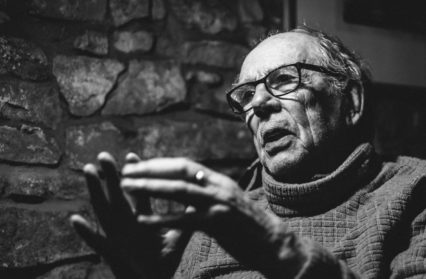Adam Somerset admires the BBC’s tribute to the iconic Welsh photographer, David Hurn, following his life and career through his photographs.
The quality of television documentary is, to put it diplomatically, variable. A documentary for Easter had a subject of interest, a knowledgeable presenter, expensive location filming and was unwatchable. The music that accompanied it was grotesquely overblown to the extent of ruining the visuals. Within two minutes it was time to grab the controller for the “off” button. By contrast David Hurn: A Life in Pictures, only forty minutes in length, is a model of economy, insight and completeness. The key production members for Telesgop are Molly-Anna Woods, David L Rees and Steve Freer, respectively producer, editor and director.
The makers admittedly start with an advantage. David Hurn is aged 83 and a good interviewee. His sentences are both eloquent and to the point. The heart of his own aesthetic has not changed in 60 years. “My photography,” he says, “relies on warmth and liking people and trying to understand what they are doing.” The makers have also interviewed people who count. The contributions from Martin Parr, Don McCullin and Bronwen Colquhoun from the National Museum of Wales are edited to a finesse of meaning. That 40-minute length imposes discipline. Sports photographer Tom Jenkins pays tribute to the inspirational rigour of Hurn as an educator. Hurn himself says that the location was good. Newport was “a tough old place”. Students were sent out day after day and each frame on their contact sheets was subject to a scrutiny of assessment.
The makers have also used their budget to achieve high visual contrasts. The opening sequences travel the palm-lined avenues of Southern California. The occasion is a warm re-meeting with Jane Fonda. Hurn uses the opportunity to take pictures on Venice Beach. The film moves to the Wye and Tintern in a morning mist, to the peak of Snowdon and finally to a celebratory exhibition at the National Museum. These present day sequences are interspersed with film footage from the life and times.
Hurn started early, hitch-hiking at age 22 to Austria. By chance he met up with some ambulances and got a lift on to Budapest. His pictures from the 1956 uprising stood out and appeared in the Observer and the Picture Post. In London he was friends with Ken Russell who featured him in two television documentaries. Watch the Birdie of 1963 shows him with a group of nuns nursing the ill and dying in a then run-down Notting Hill Gate. He was on location for A Hard Day’s Night. The most famous picture of Peter O’Toole, straight out of RADA, was his. All careers meld dedication with opportunity. The time, he says, was a good one. The press launched colour supplements with a huge demand for pictures. There was a relationship of trust, he says, 50 years ago. “Of course,” he adds, “the media has grown less trustworthy.”
In the film he stresses his aesthetics of feeling. A photograph is “capturing the essence of what you feel about something.” He featured in a long interview with Jo Mazelis in Wales Arts Review in September 2015. There he spoke about photography: “You have a mess which instantaneously you are trying to make into some sort of formal statement and if you don’t get it that’s it.”
He was also keynote speaker for the Eye International Photography Festival at Aberystwyth in 2012. “Photography is emotion,” ran the report for Wales Arts Review in July 2012. He is an exponent of craft. Getting into art college alone will not make an artist. “What is the essence of being a concert pianist?” he once enquired of Daniel Barenboim. “You get to play the piano a lot,” is the master’s reply. “Get on with making photographs, he says, lots and lots of them.”
Back in 2018, the documentary uses its voice-over presenter economically. The script summarises a view of the work. “In all his photographs there is a humanity, a warmth and an impish sense of humour.”
This is a fine television contribution to the arts of Wales.
David Hurn: A Life in Pictures is available on the BBC iPlayer.
You might also like…
Ben Woolhead was at the Cardiff School of Journalism and Media for the final public event in the long career of one of Wales’ most iconic Magnum Photography photographers, David Hurn.
Adam Somerset is a regular contributor to Wales Arts Review.












